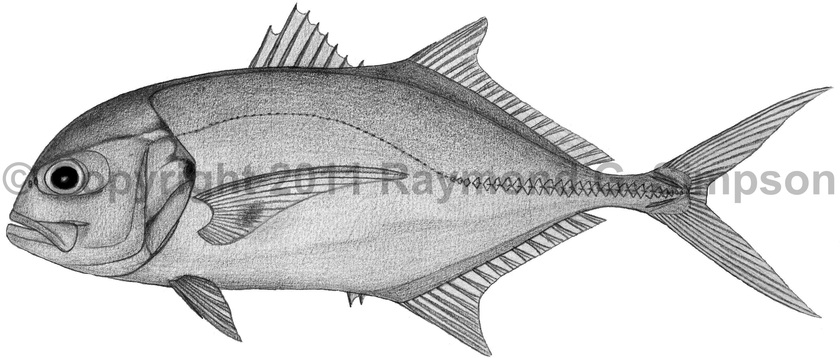
Common Name
Crevalle Jack
Year Described
Linnaeus, 1766
Identification
Dorsal Fin: 8 spines in first lobe, followed by I, 19-21
Anal Fin: 2 spines separate from rest, followed by I, 16,17
Pelvic Fin: I, 5
Gill Rakers: 6-9 upper, 16-19 lower
Vertebrae: 10 precaudal, 14 caudal
Elongate, compressed, and deep-bodied, with a large head, blunt snout, and a large eye (3.8-4.2 times in HL). Adipose eyelid strong. Snout short; jaw reaches beyond posterior margin of eye. Teeth in two rows in the upper jaw (with strong canines) and a single row in the lower jaw. Pectoral fins falcate, longer than head. Spiny dorsal fin lower than lobe of second dorsal fin. Anterior lobe of second dorsal and anal fin raised. Tail deeply forked. Lateral line with an strong anterior arch and a straight posterior portion with 23-35 scutes. Small cycloid scales on body except for naked chest (a small patch of scales anterior to pelvic base). Bilateral caudal keels present. Hyperostosis present.
Color
Dark blue, green to gray above, silvery on sides, and white on belly. Golden sheen often on the ventral midline and along the anal fin base. A dark blotch on the upper gill cover and also on the lower pectoral fin. Dorsal fin often dusky with a dark posterior margin. Anal fin yellow. Caudal and pectoral fins yellowish to dusky (large fish with dark posterior margin). Juveniles with dark body bands and a partial eyeband.
Size
Common to 60cm FL. Maximum size to more than 120cm FL.
Habitat
Continental shelf waters: pelagic or near the bottom. Occurs closer to shore at small size, moving to deeper water with age. Juveniles occur in the surf zone or in estuaries. Small fish in large schools but large adults can be solitary.
Range
Nova Scotia to Uruguay, including the Caribbean islands.
References
Smith-Vaniz, W.F. 2003. Carangidae (pp 1426-1468). In: Carpenter. 2003. The living marine resources of the Western Central Atlantic v. 3.